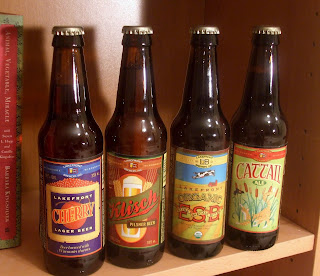Homebrew!
It's funny. I never had the slightest interest in homebrewing, but this summer I suddenly got the itch and it wouldn't go away, so I succumbed. There were two main reasons I wasn't interested in homebrewing:
- Sanitation. Who wants a hobby that stresses cleanliness so heavily?
- I'm not a big drinker. I mean, I like beer a lot, but I like to drink as many different ones as possible rather than a bunch of the same. What would I do with two cases of possibly mediocre suds?
But for whatever reason, I took the plunge. I bought a basic equipment kit (plastic pail, no wort chiller or anything) and a True Brew Nut Brown Ale kit. My guide was Palmer's
How to Brew, which I might write about in a separate post. I also tried to read as many web pages as possible about the hobby.

The True Brew Nut Brown Ale kit includes Munton's ingredients: a can of hopped light LME, one pound each of pound of amber and light DME, a pound of brown sugar (!), specialty grains (chocolate malt, dark crystal and black patent), Fuggles finishing hops, and Munton's Dry Yeast.
I brewed this first batch on one of the many unfortunately hot weekends in July. I prepped as much as possible and things went well... up to a point.
My first mistake was dumping my sanitizer when I thought I was done with it. I ended up needing more for items I'd forgotten about. My second problem was cooling the wort. Despite only doing a partial boil, it took me way too long using an ice bath. On hindsight, I should have stirred the water outside the pot (or stirred the wort inside it) to get some convection going. I impatiently pitched my (re-hydrated, as per Palmer) yeast at 73-74 degrees.
I also didn't aerate the wort enough, and the top off water I used had been boiled, which I think means it lost most of its oxygen. I stored my fermenter in a basement storage area that was a tad over 70 degrees, but the temperature inside the vessel was in the high 70s when fermenting. This meant quick fermentation, but also some wayward esters. The FG never made it below 1.020 (it was supposed to be 1.012-14). The OG was supposed to be 1.050, though I never verified that. Poor attenuation. Poor brewing, I suppose, although I've discovered that a lot of people have problems with Munton's regular dry yeast.
About bottling day, the less said the better. What a mess. Someone's going to say I should switch to kegging, but I really don't want to invest more money until I brew a few more batches. After bottling was done, I really needed a beer, and what I had (something from Flying Dog, I think) was the best beer I’d ever drank if for no other reason than I had no need to de-label the bastard afterward. (For the record, Hoegaarden labels are super easy to remove, but don't even bother with St. Peters.)
I poured my first beer two weeks after bottling, four weeks after brewing, and it was murky and, of all things, a tad astringent, powdery on the back of the tongue. Did I boil the specialty grains? I don't think so. But that was the only bottle that felt like that. In successive beers I've tasted a bunch of wrong flavors, though it seems to be improving. Maybe it will taste good someday. What's always been good about it is the big, fluffy head that sticks to the glass as you drink it, as well as the spot on carbonation (I used 3.5 ounces of corn sugar instead of 5, in part due to my high ending FG).
So overall, what do I make of it? In cooking terms, homebrewing seems like a cross between making chicken broth and baking, in its emphasis on sanitation and precision, respectively. This isn't the casual stew or soup making we all know and love. It has a comical ratio of doing-to-waiting. And it isn't necessarily value for the money; better to think of those dollars as coming out of your hobby/entertainment budget than your beer budget. Nonetheless, I can't wait to brew again, and spend hours planning my next batch, not to mention the batch after that.









































